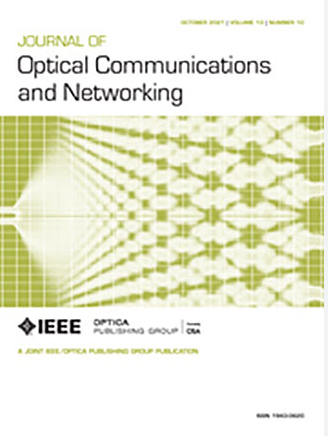Data transfer method combining erasure coding and cumulative decoding-status feedback: demonstration on an optical packet-switching network testbed
IF 4.3
2区 计算机科学
Q1 COMPUTER SCIENCE, HARDWARE & ARCHITECTURE
引用次数: 0
Abstract
Optical packet-switching (OPS) networks remain an emerging technology, as exemplified by the feasibility challenges of optical RAM. Nevertheless, OPS networks possess significant potential advantages, including a high data transfer rate and low power consumption due to the elimination of optical–electrical–optical conversion, compared to conventional electronic packet-switching networks, flexibility in handling traffic fluctuations due to packet-switching principles, and low latency as they do not require overhead for communication path establishment. However, effective data recovery from non-negligible packet loss due to optical packet collisions remains a critical challenge in OPS networks. Packet-level forward error correction (FEC) is regarded as an effective data recovery method for lossy networks, such as OPS ones, because it does not rely on packet-by-packet feedback, which could be lost, and avoids the delays associated with feedback and retransmission. On the other hand, FEC requires the transmission of additional packets beyond the original data, increasing the computational load associated with encoding and decoding. In this paper, we propose a data transfer method based on erasure coding, which is useful not only in OPS networks but also in other network environments suffering from severe packet loss due to collisions or signal degradation, such as optical circuit switching networks and wireless networks. This method improves effective data transfer throughput by limiting the number of transmitted packets and reducing the computational overhead of the encoding and decoding processes. This improvement is achieved through the appropriate configuration of the distribution of XOR operation target packets that constitute XOR packets, thereby restricting the number of symbols encoded in each XOR operation and introducing cumulative feedback of which symbols were already recovered at the receiver. To validate the proposed method, we conducted not only simulation evaluations but also what we believe to be the world’s first packet transmission demonstration experiment using packet-level erasure coding over an actual OPS network testbed, taking actual computational overhead into account. The experimental results show that, in high transmission rate environments, the proposed method achieves up to a 188.7% increase in effective data transfer throughput compared to the benchmark LT-Codes-based packet-level FEC transmission method while reducing the processing time on the sender side by up to 15.6% and on the receiver side by up to 39.4%. In addition, the number of packets required for data decoding can be reduced by up to 63.3%.结合擦除编码和累积解码-状态反馈的数据传输方法:在光分组交换网络测试平台上的演示
光分组交换(OPS)网络仍然是一项新兴技术,光RAM的可行性挑战就是一个例子。然而,OPS网络具有显著的潜在优势,包括与传统的电子分组交换网络相比,由于消除了光-电-光转换而具有高数据传输速率和低功耗,由于分组交换原理而在处理流量波动方面具有灵活性,并且由于不需要建立通信路径的开销而具有低延迟。然而,如何从光包碰撞造成的不可忽略的丢包中有效地恢复数据仍然是OPS网络中的一个关键挑战。包级前向纠错(Packet-level forward error correction, FEC)由于不依赖于可能丢失的逐包反馈,避免了反馈和重传带来的延迟,被认为是OPS等有损耗网络中有效的数据恢复方法。另一方面,FEC需要在原始数据之外传输额外的数据包,增加了与编码和解码相关的计算负荷。本文提出了一种基于擦除编码的数据传输方法,该方法不仅适用于OPS网络,而且适用于光电路交换网络和无线网络等由于碰撞或信号退化导致的严重丢包的网络环境。该方法通过限制传输数据包的数量和减少编码和解码过程的计算开销来提高有效的数据传输吞吐量。这种改进是通过适当配置构成异或包的异或操作目标包的分布来实现的,从而限制每个异或操作中编码的符号数量,并引入在接收端已经恢复的符号的累积反馈。为了验证所提出的方法,我们不仅进行了模拟评估,而且考虑到实际的计算开销,我们还在实际的OPS网络测试台上进行了我们认为是世界上第一个使用包级擦除编码的分组传输演示实验。实验结果表明,在高传输速率环境下,与基准的基于lt - code的分组级FEC传输方法相比,该方法的有效数据传输吞吐量提高了188.7%,发送端和接收端的处理时间分别缩短了15.6%和39.4%。此外,数据解码所需的数据包数量最多可减少63.3%。
本文章由计算机程序翻译,如有差异,请以英文原文为准。
求助全文
约1分钟内获得全文
求助全文
来源期刊
CiteScore
9.40
自引率
16.00%
发文量
104
审稿时长
4 months
期刊介绍:
The scope of the Journal includes advances in the state-of-the-art of optical networking science, technology, and engineering. Both theoretical contributions (including new techniques, concepts, analyses, and economic studies) and practical contributions (including optical networking experiments, prototypes, and new applications) are encouraged. Subareas of interest include the architecture and design of optical networks, optical network survivability and security, software-defined optical networking, elastic optical networks, data and control plane advances, network management related innovation, and optical access networks. Enabling technologies and their applications are suitable topics only if the results are shown to directly impact optical networking beyond simple point-to-point networks.

 求助内容:
求助内容: 应助结果提醒方式:
应助结果提醒方式:


